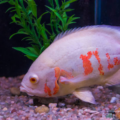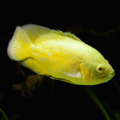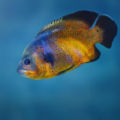Let’s dive into the enchanting world of the Blue Oscar Fish! A truly beautiful freshwater fish that has been a favorite among aquarium hobbyists for centuries.

Introduction to Blue Oscar Fish
Blue Oscars belong to the family of the famous Oscar fish. If you are familiar with the Oscar fish varieties, then you are no stranger to this species’ outstanding abilities and beauty.
This variety of Oscar fish has a vibrant blue color and beautiful patterns, making them stand out among other aquarium fish. They have engaging personalities and unique characteristics that could make anyone swoon over them.
But don’t be carried away by their puppy-like personality; these large fish can get aggressive towards their tank mates.
In this guide, I’ll explain everything you need to know about this popular aquarium fish and how you can create an environment that optimizes their growth and ensures their happiness.
History and Origin
Learning about the Blue Oscar fish’s history is the first place to start if you want to own one of these lovely creatures. Scientifically known as Astronotus ocellatus, the Blue Oscar fish are native to the freshwater environments of South America.
They can be found in areas like Brazil, Colombia, and Ecuador. The origin of the Blue Oscar may be a contributing factor to its striking appearance, but it’s undeniable that its stunning blue appearance makes it a favorite among aquarium enthusiasts.
Due to the wild environment they originate from, these South American cichlids have adapted to feeding on live insects, small crustaceans and even smaller fish.
Generally, the Oscar fish’s natural habitat is stagnant or slow-moving waters with plants that serve as hiding spots and provide food and shelter. These living conditions are essential to their survival, so creating an environment as close as possible to their natural habitat is important. You can recreate this by including live plants in your tank setup, giving them the needed stimulation.
Physical Characteristics

The Blue Oscar Fish’s appearance is quite mesmerizing, with unique features and color patterns that make you want to stare at them all day. Here are some of the stunning features this specie possess:
Size
Blue Oscars have a sleek body structure with long, flowing fins that allow them to swim elegantly. They are large in size, usually growing up to 12-14 inches (30 – 36 cm) and weighing up to 3.5 pounds when fully mature.
Coloration

The most striking feature of the blue Oscar is its vibrant blue coloration. It can vary from a deep hue to a dark grey or even black shade. This beautiful hue is accompanied by black spots and patterns, making it visually appealing.
Blue Oscars also exhibit color variants. A popular variation is the albino variety, which appears white or pale yellow because it lacks pigmentation.
Traits
Like other Oscars, the blue Oscar fish’s personality traits are fun and engaging. These fish love to seek attention from their owners by wagging their tails and even performing tricks.
They love jumping and getting aggressive, often attacking other fish and eating smaller ones. I would advise avoiding smaller fish as tankmates and pairing them with other large-sized fish or fish of the same variety.
Distinctive Markings
In addition to their beautiful coloration, Oscar fish also have distinctive markings. These markings include the ocelli, which are large black spots with orange rings located around the base of their tail.
Wild Oscars may exhibit a darker olive or brown base color with irregular dark blotches, and younger ones may display white and orange patterns.
Ideal Tank Setup

The importance of providing a comfortable habitat for your pet cannot be overemphasized. Setting up an aquarium close to your Blue Oscar’s natural environment is essential for creating the right environment for your Blue Oscar.
The ideal Blue Oscar fish tank setup should have ample space for swimming, live plants, hiding spots and a suitable substrate.
The recommended tank size for a Blue Oscar should be at least 55 gallons, but I would suggest adding a few more gallons to keep your Oscar comfortable and avoid stress. A comfortable aquarium set up for your pet would contain at least 90 gallons of water.
Water Parameter
Oscars are hardy fish that require specific water parameters to survive. The water temperature must be between 74°F and 81°F, and the pH should be between 7 and 8. It is important to maintain stable conditions and keep adjustments to a minimum.
We highly recommend getting an API Freshwater Master Test Kit to ensure your aquatic pets water parameters are perfect!
Filtration
Oscar fish are large, and with that size they produce a large amount of waste. To maintain a clean and healthy environment, you must install a strong filtration system in your tank.
A tank with an adequate filtration system for an Oscar fish is essential to reducing the toxic waste products of these fish and allowing for a balanced ecosystem.
You can choose between one large filter and two to three smaller filters to provide the best conditions for these beautiful species.
Decorations
Adding tank decorations to your pet’s home provides enrichment while adding visual appeal to the aquarium.
You can opt for live plants like Amazon swords or plastic plants made from non-toxic material.
You could also include rocks, caves, and driftwood to recreate your pet’s natural habitat.
Feeding and Diet

Feeding your Blue Oscar a well-balanced diet is the best way to ensure their health and happiness.
Blue Oscar Fish’s diet is heavily influenced by their wild habitat, and they eat more live foods than frozen foods.
Feeding a Blue Oscar involves understanding their dietary requirements and creating an appropriate feeding schedule.
To maintain a balanced diet for your pet, here are a few healthy meal options:
· Live foods: small insects, crickets, mealworms, and other feeder fish.
· Frozen foods: bloodworms, krill, and beef hearts.
· Vegetables: peas, spinach, lettuce or zucchini
To improve your fish’s nutrition, you can include commercial flake foods and high-quality pellets.
It is quite important to create an appropriate feeding technique for your Oscar to avoid overfeeding and maintain their overall well-being.
Feeding techniques could include portion control, feeding at least twice daily, or mixing various foods.
For more on feeding your aquatic pets check out The Ultimate Guide to Fish Food: Pros and Cons & Best Choices!
Health and Common Diseases
Oscars are sturdy fish with a strong and resilient immune system. However, the Blue Oscar Fish’s health can be susceptible to certain diseases. Here are some of the common fish illnesses you should look out for.
· Fin rot is a bacterial infection that results in decayed or frayed fins. It could be caused by poor water conditions or injuries. Fin rot can easily be treated with over-the-counter antibiotics.
· Hole in the head: This appears as small holes and sores on the fish’s head.
· Dropsy: This condition is marked by swelling of the fish’s body due to fluid accumulation.
Proper fish care is important to avoid these diseases and keep your pet in the best shape. Disease prevention measures like proper filtration, maintaining water quality and regular tank cleaning should be implemented. If you notice any behavioral changes, it is important to administer fish treatment immediately or call your veterinarian.
Breeding Blue Oscar Fish
Breeding the Blue Oscar is the most exciting part of owning this species. Breeding the Blue Oscar fish is a pretty fascinating process, although quite demanding.
Providing the ideal breeding setup for your pet makes this process less difficult and increases your chances of successful reproduction.
One of the major difficulties in breeding this species is how picky they are when selecting a mate. To encourage mating, it’s important to introduce mating pairs early and perform water changes every 2-3 days.
This video has been very helpful in identifying the sex of Oscar fish, I highly recommend it:
Provide a flat surface in the breeding tank for the eggs to be laid. Blue Oscar fry typically hatch 72 hours after the eggs are laid, so prepare another tank to raise the fry.
Certain conditions must be met in the breeding tanks. A minimum tank size of 125 gallons with a secure lid should be acquired.
Remember water temperature must be maintained at 77-82°F (25-28°C), pH 6.6-7.5 and water hardness 5-15dGH. It’s important to maintain stable breeding conditions for the survival of the fish fry.
Here are essential fish breeding tips for your cichlids:
· Provide a high-quality diet for the breeding pair and feed them multiple times daily to ensure they are well-nourished.
· Monitor the eggs closely and maintain the ideal temperature to facilitate hatching.
· Once the fry swims freely, feed them with crushed flakes or specialized fry food.
Behavior and Compatibility

Blue Oscar Fish’s behavior and temperament are well-known. Understanding their compatibility with other fish is important when creating an environment for them.
Blue Oscars are voracious eaters who tend to devour their food eagerly and eat anything that fits their mouths. Do not pair them with smaller fish; they will eat them. They are also curious creatures who spend their time investigating and may even rearrange the decorations or substrate.
Oscars can get aggressive when they feel threatened or need to establish dominance. When pairing them with other fish, it’s important to opt for fish of the same size and with the same temperament. Here are some of the fish tank mates your Oscar may be comfortable with:
· Bala Shark
· Severum
· Jack Dempsey
· Clown Loach
· Convict Cichlid
If you are building a community tank, it’s essential to understand your aquarium fish’s behavior to ensure maximum compatibility. Here are some strategies for managing aggressive fish:
· Provide hiding spots to reduce stress on less dominant fish
· Rearrange the tank by adding new elements and moving decorations
· Feed strategically
· Increase tank size
Conclusion
Blue Oscar fish care is not as complicated as it may seem. In this guide, I’ve provided important fish-keeping tips and ways to ensure your pet’s happiness and longevity. With the proper setup, keeping Blue Oscars as an aquarium hobby would be an exciting and fulfilling journey.











